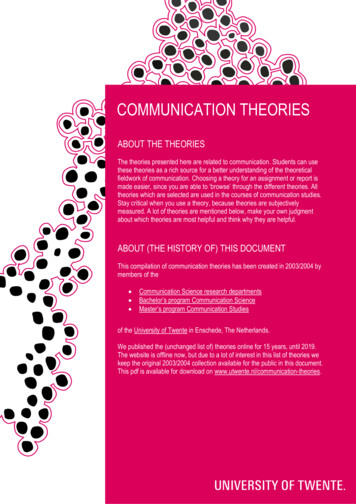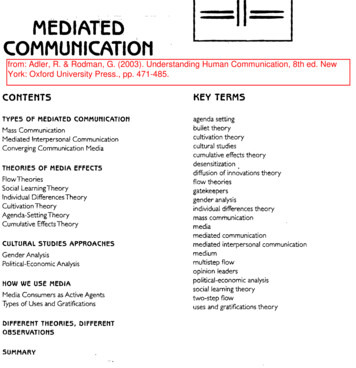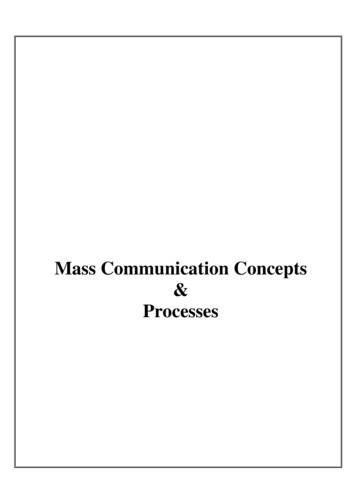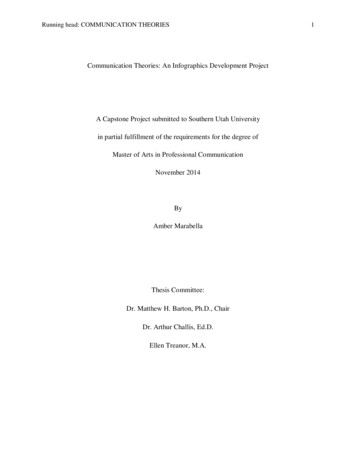
Transcription
Communication Theories for Advocacy: AnAnalytical PerspectiveI.The “Tactical Theory of Change” can be an excellent guide for theoreticalgroundings in Advocacy works. From the review of various advocacy works,it can be clearly seen that advocacy efforts are impactful and successful ifstrategic and persuasive communication approaches are well-planned, well–implemented, and thoroughly monitored (click: Communication Theoriesin Advocacy Works materials reviewed).The “Tactical Theories of Change for Advocacy” (Stachowiak, 2013) is anoutcomes-based advocacy model or framework that can be used as acomprehensive guide for advocacy programs (click: Tactical Theories).II.Communication Paradigms prove useful in the discourse of inherentobstacles to successful advocacy works as explained by SelectivePerception, Selective Exposure and Selective Retention Theory (see SlideNo. 4 of this presentation).
I. THE TACTICAL THEORIES OF CHANGE AS THEORETICALGROUNDING FOR ADVOCACY WORK The “Tactical Theory of Change” can be anexcellent guide for theoretical groundings inAdvocacy works. From the review of variousadvocacy works, it can be clearly seen thatadvocacy efforts are impactful and successful ifstrategic and persuasive communicationapproaches are well-planned, well –implemented,and thoroughly monitored (click: CommunicationTheories in Advocacy Works materials reviewed).
A Comprehensive Approach to Advocacy:“Tactical Theory of Change” The work of Sarah Stachowiak (2013, pp. 17-31) is by far the mostcomprehensive theoretically grounded perspective on advocacyand policy change. This reporter feels that reinventing the wheel isnot wise at all. The tactical theories of change can be used for various advocacyworks and they are so encompassing for the much neededcommunication strategies in advocacy endeavors.
WHAT IS THE TACTICAL “THEORY OF CHANGE”FOR ADVOCACY FRAMEWORKS?The “Theory of Change can be defined as the conceptual model forachieving a collective vision. A theory of change typically addresses thelinkages among the strategies, outcomes, and goals that support a broadermission or vision, along with the underlying assumptions that are related tothese linkages. Theories of change can be expressed in many forms butultimately should explain how you get from “here” to “there.”(Organizational Research Services, 2007)Organizational Research Services. (2007). A guide to measuring advocacy and policy. Prepared for theAnnie E. Casey Foundation. Seattle, WA. D as cited in page 2 of Sarah Stachowiak (2013) PATHWAYS FORCHANGE: 10 Theories to Inform Advocacy and Policy Change Efforts
The Tactical Theories for Advocacy Briefly summarized, the 10 social science theories of change relevant to advocacy andpolicy change efforts comprise two types of theories: Tactical theories: theories from various social science disciplinesthat apply to common advocacy (tactics that are likely part of broaderadvocacy efforts or campaigns) Global theories: theories that explain how policy change occurs morebroadly(Stachowiak, 2013)
Global theories of change include:Tactical theories of change include: “Large Leaps” or PunctuatedEquilibrium theory “Messaging and Frameworks”Theory “Policy Windows” or Agenda-Settingtheory3 “Media Influence” or AgendaSetting theory3 “Coalition” theory or AdvocacyCoalition Framework “Grassroots” or CommunityOrganizing theory “Power Politics” or Power Elitestheory “Group Formation” or SelfCategorization theory “Regime” theory “Diffusion” theory or Diffusion ofInnovations(Stachowiak, 2013)(Sarah Stachowiak (2013, pp. 17-31)Module 2 focuses on Advocacy Works so, for the graphical models for each ofthe following Tactical Theories: Tactical Theories.
The “Tactical Theories of Change” (Stachowiak, 2013,pp. 17-31) can be used as an excellent theoreticalgrounding for Advocacy.It provides outcomes-based advocacy framework andis a comprehensive guide that provides solution toreducing obstacles and ensuring successful advocacyprograms (click: Tactical Theories).
II. THE USEFULNESS OF COMMUNICATION PARADIGMSON INHERENT COMMUNICATION OBSTACLES Communication Paradigms proveuseful in the discourse on inherentobstacles to successful advocacyworks as explained by SelectivePerception, Selective Exposure andSelective Retention Theory (see SlideNo. 10 of this presentation).
A Theoretical Perspective for Successful Advocacy:The Usefulness of Communication ParadigmsIt can also be seen that communication strategy isexecuted through the principles of communication fordevelopment, and communication for development is avehicle through which advocacy programs can result insocial mobilization, behavior change, and/or policychange.This brings us to the discussion of the CommunicationParadigms.If you want to have the detailed discussion of Communication Paradigms nication.htmlFor supplementary materials on Communication Theories in Advocacy Works, nication.html
Inherent Communication Obstacles Mass-media is not a sufficient cause of change; and, masscommunication serves as a contributory agent but may not be thesole factor of change This is explained by the following theories: Selective exposure -- the people's predisposition to exposethemselves to mass communications that align with theirattitudes and interests. Selective perception and retention - the people's predispositionto dispose the meaning of mass communication messages inorder to bring these messages into accord with their alreadyexisting views. People’s interaction with members of their social group usuallyreinforces their beliefs and the effects of Selection Perception andRetention Theories.Source: The Dominant Paradigm: communication-convergences
Concluding Thoughts and Reflection In mass media, group, and interpersonal communications, themost pervasive obstacle to effective communication due toselective exposure, selective perception, and selectiveretention can be make communication endeavorsineffective.Debate Question: Is the “Tactical Theories of Change” as theoretical groundingfor various advocacy works help an effective means toovercome communication obstacles? If you say, YES, why? Ifyou say, NO, why not?For the graphical models for each of the Tactical Theories, please, download:Tactical Theories 92560/tactical theories for advocacy works.pdf
References Cited and Sources Reviewedto Validate the Theoretical Perspective Conceptual Frameworks for Strategic Communication Chapter 2. ccp.jhu.edu/. Retrievedfrom http://ccp.jhu.edu/documents/Chapter%202%20.pdf Family Tree of Theories, Methodologies and Strategies in Development Communication:Convergences and Differences. (2003). The Communication Initiative Network. Retrievedfrom communication-convergences Organizational Research Services. (2007). A guide to measuring advocacy and policy.Prepared for the Annie E. Casey Foundation. Seattle, WA. D as cited in page 2 of SarahStachowiak (2013) PATHWAYS FOR CHANGE: 10 Theories to Inform Advocacy and PolicyChange Effortsea Stachowiak, S. (2013). Pathways for change. 10 Theories to Inform Advocacy andPolicy Change Efforts Sample advocacy works and their theoretical groundings ation.html The Dominant Paradigm: communication-convergences
For Sample Advocacy Works and their Theoretical Groundings nication.html click on each titleunder Communication Theories in Advocacy Works.
Inherent Communication Obstacles Mass-media is not a sufficient cause of change; and, mass-communication serves as a contributory agent but may not be the sole factor of change This is explained by the following theories: Selective exposure -- the people's predisposition to expose themselves to










